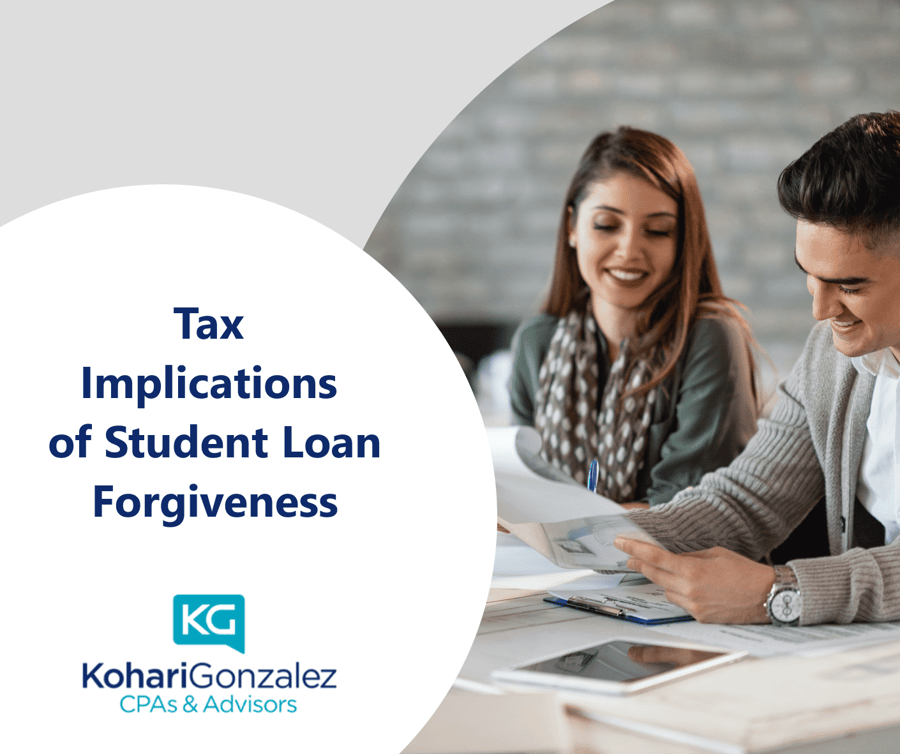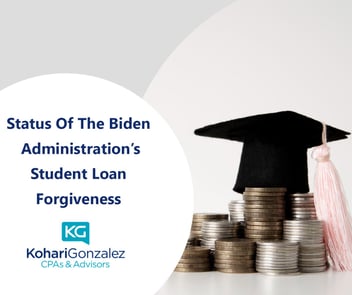
Article Highlights:
- Background
- Court Battle
- Forgiveness Under Income-Driven Repayment (IDR) Plans
- Debt Relief Income
- American Rescue Plan Act
- General Welfare Exception
- Insolvent Taxpayer Exclusion
- Employer-Provided Educational Assistance
- Sec 529 Plans
Back in August of 2022, President Biden issued an executive order that would forgive federal student loan debt for lower income individuals. The program would have provided up to $20,000 in loan relief to borrowers with loans held by the Department of Education (DOE) whose individual income is less than $125,000 ($250,000 for married couples) and who received a Pell Grant. Borrowers who meet those income standards but did not receive a Pell Grant in college would have received up to $10,000 in loan relief.
However, this program subsequently hit a snag when two court cases put a hold on the plan, which was one of Biden’s campaign promises. Those who brought the suits, as well as others, contend the President does not have the authority to forgive the debt, that it is the sole prerogative of Congress. The issue wound up at the Supreme Court which ruled against the plan at the end of June 2023.
The Biden administration has since turned toward forgiveness under the income-driven repayment (IDR) plans where under the Higher Education Act and the DOE’s regulations, a borrower is eligible for forgiveness after making 240 or 300 monthly payments—the equivalent of 20 or 25 years—on an IDR plan or the standard repayment plan, with the number of required payments varying based upon when a borrower first took out the loans, the type of loans they borrowed, and the IDR payment plan in which the borrower is enrolled. Inaccurate payment counts over the years have resulted in borrowers losing progress toward loan forgiveness, so as part of the new arrangement the records have been cleaned up. This action also addresses concerns about practices by loan servicers that put borrowers into forbearance in violation of Department rules. Under this Biden plan
, $39 billions of student debt would be wiped away for approximately 804,000 borrowers in the very near future.
So, if your student loan debt is forgiven, what are the tax consequences? The Internal Revenue Code Section 61, says that all kinds of income, including earned, found, or won, is income for tax purposes unless specifically excluded. Taking that to extremes, if you find, for example, a $20 bill on the sidewalk while out for your morning walk that is technically income.
However, the American Rescue Plan Act (ARPA) passed in 2021 included a provision that makes student loan forgiveness free from federal income tax for 2021 through 2025 if the loan was one of the following.
- A loan for postsecondary educational expenses from the federal or a state government or most educational organizations.
- A private education loan made expressly for postsecondary educational expenses.
- A loan from an educational organization that maintains a regular faculty and curriculum and normally has a regularly enrolled student body at its facility.
- A loan from an organization exempt from tax–for example, charitable, religious and educational organizations–to refinance a student loan.
So, in most cases if your loan is forgiven before 2026 you don’t have any debt forgiveness income to be concerned about for federal purposes.
But what happens after that? The exclusion could be extended, or it could be allowed to lapse (sunset in tax lingo), which would mean the amount forgiven would be taxable income in the year forgiven, and the tax would be your top marginal rate times the forgiven amount. However, there are a couple of other options that might be available to exclude the income.
- General Welfare Exception (GWE) - The first is a little-known administrative exception, called the general welfare exception (GWE), which allows some payments to be excluded from income. The IRS has consistently concluded that payments to individuals by government units, under legislatively provided social benefit programs, for the promotion of the general welfare, are not includible in a recipient’s income. Typically, to be excluded, these payments must be to pay or reimburse expenses for essential items such as food, medical, housing or heating costs.
However, what any individual taxpayer “needs” is a subjective determination, and the IRS has applied the GWE to many different contexts, including education assistance.
- Insolvent Taxpayer Exclusion – Another option, if the student loan debt exceeds the taxpayer’s assets, just preceding the forgiveness, the insolvent taxpayer exclusion allows a taxpayer to exclude debt relief to the extent the taxpayer’s debts exceed their assets.
In addition there are also state tax issues that can come into play where the taxpayer is a resident of a state with income tax. While most states will conform to federal law, there are those that may not, as detailed in a Tax Foundation report.
With all that said there are other tax provisions that can help a taxpayer pay off their student loan debt.
- Employer-Provided Educational Assistance – If the taxpayer’s employer has an employer-provided educational assistance plan, that plan can pay tax free to the employee up to $5,250 per year towards the employee’s student loan debt. This provision is available through 2025.
- Sec 529 Plans - Distributions from a 529 plan of up to $10,000 – a lifetime limit – may be used to pay the principal and interest on qualified higher education loans of the designated beneficiary or a sibling of the designated beneficiary.
- Employer Matching Contributions – Traditionally, employer retirement plans such as 401(k) and 403(b) plans permit the employer to match employee contributions to the plan based on the employee contributions or elective deferrals. For plan years beginning after 2023, employers may treat qualified student loan payments as elective deferrals for purposes of making matching contributions. Meaning employers can make matching contributions based on their employee’s student loan payments, rather than on amounts that are contributed to the plan.
If you have any questions related to the foregoing, please give this office a call.



